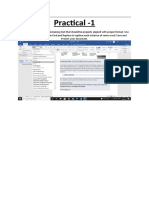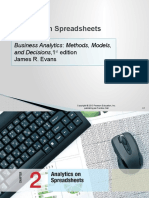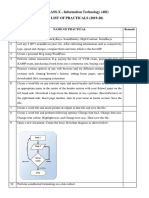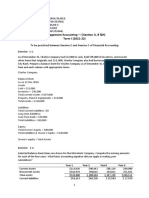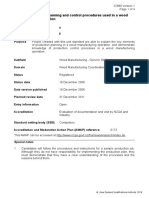0 ratings0% found this document useful (0 votes)
749 viewsAssignment Problem in Excel - EASY Excel Tutorial
Excel Tutorial
Uploaded by
TrinhTruongCopyright
© © All Rights Reserved
We take content rights seriously. If you suspect this is your content, claim it here.
Available Formats
Download as PDF or read online on Scribd
0 ratings0% found this document useful (0 votes)
749 viewsAssignment Problem in Excel - EASY Excel Tutorial
Excel Tutorial
Uploaded by
TrinhTruongCopyright
© © All Rights Reserved
We take content rights seriously. If you suspect this is your content, claim it here.
Available Formats
Download as PDF or read online on Scribd
You are on page 1/ 6
Formulate the Model
Formulate the Model | Trial and Error | Solve the Model
Use the solver in Excel to find the assignment of persons to tasks that minimizes the total
cost.
The model we are going to solve looks as follows in Excel.
A 8 c D Ele 6 a] ia
1 Assignment Problem
2
3 Cost Task 1 Task 2, Task 3
4 Person 1
5 Person 2
6 Person 3
7
8
9 Assignment Task 1 Task 2. Task 3 Tasks Assigned Supph
10 Person 1 0 = 1
ab Person 2 0 1
12 Person 3 0 = 1
B
14| Persons Assigned 0 D 0
acy = = Total Cost
16 Demand 1 4 1
v7
1, To formulate this assignment problem, answer the following three questions,
a. What are the decisions to be made? For this problem, we need Excel to find out which
person to assign to which task (Yes=1, No=0). For example, if we assign Person 1 to Task
1, cell C10 equals 1. If not, cell C10 equals 0.
b. What are the constraints on these decisions? Each person can only do one task
(Supply=1). Each task only needs one person (Demand=1).
c. What is the overall measure of performance for these decisions? The overall measure of
performance is the total cost of the assignment, so the objective is to minimize this
quantity.
2. To make the model easier to understand, name the following ranges.
Range Name Cells
Cost 4:66
Assignment
PersonsAssigned
Demand
TasksAssigned G10:G12
Supply 110:112
Totalcost 116
3. Insert the following functions.
Task 1 Task 2 Task 3
Task 1 Task 2 Task3 Tasks Assigned 3u
-=SUM(C10E10) =[1
=SUM(C11:E11) =|1
-=SUM(C12E12) =|1
‘=SUM(C10:012) =SUM(D 10-012) =SUM(E10E12)
Explanation: The SUM functions calculate the number of tasks assigned to a person and
the number of persons assigned to a task, Total Cost equals the sumproduct of Cost and
Assignment.
Trial and Error
With this formulation, it becomes easy to analyze any trial solution.
For example, if we assign Person 1 to Task 1, Person 2 to task 2 and Person 3 to Task 3,
Tasks Assigned equals Supply and Persons Assigned equals Demand, This solution has a
total cost of 147.
[a 8 c D Ele 6 a] ia
1 Assignment Problem
2
3 Cost Task 1 Task 2 Task 3
4 Person 1
5 Person 2
6 Person 3
7
z
8
Assignment Task 1 Task 2. Task 3 Tasks Assigned
vo bso! [ioe
uw Person 2 1 ={ 4
2 Person 3 1 1
a
14] Persons Assigned 1 1 1
3 = Total Cost
16 Demand 1 1 1
v7
It is not necessary to use trial and error. We shall describe next how the Excel Solver can
be used to quickly find the optimal solution.
Solve the Model
To find the optimal solution, execute the following steps.
1. On the Data tab, in the Analyze group, click Solver.
ora
You might also like
- BA Economics FYUP Curriculum (With FirstYear Syllabus) 2023-24No ratings yetBA Economics FYUP Curriculum (With FirstYear Syllabus) 2023-2432 pages
- PVF Pvaf CVF Cvaf Tables For Financial Management - Compress100% (1)PVF Pvaf CVF Cvaf Tables For Financial Management - Compress12 pages
- 50 Ms Excel Assignments PDF For PracticeNo ratings yet50 Ms Excel Assignments PDF For Practice78 pages
- Sample Problems With Solutions On Material LevelsNo ratings yetSample Problems With Solutions On Material Levels6 pages
- IT 802 Computer Organization Class 11 Question and Answer Book BackNo ratings yetIT 802 Computer Organization Class 11 Question and Answer Book Back7 pages
- Chapter 8 B - Trendlines and Regression AnalysisNo ratings yetChapter 8 B - Trendlines and Regression Analysis73 pages
- Transportation Model: Transportation Models Play An Important Role in Logistics and Supply ChainNo ratings yetTransportation Model: Transportation Models Play An Important Role in Logistics and Supply Chain5 pages
- Ahmedabad University: Amrut Mody School of Management Financial Accounting-Fac114100% (1)Ahmedabad University: Amrut Mody School of Management Financial Accounting-Fac1143 pages
- Week 1: Practice Challenge - Taking Charge of ExcelNo ratings yetWeek 1: Practice Challenge - Taking Charge of Excel5 pages
- Analytics On Spreadsheets: Business Analytics: Methods, Models, and Decisions, 1No ratings yetAnalytics On Spreadsheets: Business Analytics: Methods, Models, and Decisions, 139 pages
- Advanced Excel Training - Learn Excel Online - Internshala TrainingsNo ratings yetAdvanced Excel Training - Learn Excel Online - Internshala Trainings4 pages
- CBSE Class 12 Typography & Computer Application Sample Question Paper 2025No ratings yetCBSE Class 12 Typography & Computer Application Sample Question Paper 20256 pages
- Unit 2 Electronic Spreadsheet Worksheet (Combined)No ratings yetUnit 2 Electronic Spreadsheet Worksheet (Combined)3 pages
- Solving Linear Programs Using Excel: Arpee Arruejo, MITNo ratings yetSolving Linear Programs Using Excel: Arpee Arruejo, MIT46 pages
- Explain Production Planning and Control Procedures Used in A Wood Manufacturing OperationNo ratings yetExplain Production Planning and Control Procedures Used in A Wood Manufacturing Operation4 pages
- Title Maintain and Control A Manufacturing Process To Ensure Product Quality Level 3 Credits 8No ratings yetTitle Maintain and Control A Manufacturing Process To Ensure Product Quality Level 3 Credits 84 pages
- Acrylic Resin Solution For Fabric Coating Toa Acron Xe-2343No ratings yetAcrylic Resin Solution For Fabric Coating Toa Acron Xe-23431 page
- Supplier+Quality+Manual+V+01 - ChemicalNo ratings yetSupplier+Quality+Manual+V+01 - Chemical62 pages
- Evaluation of Real Yarn Diameter - Processing, Dyeing & Finishing - FeaturesNo ratings yetEvaluation of Real Yarn Diameter - Processing, Dyeing & Finishing - Features7 pages
- Anti-Yellowing Inhibitor (Phenolic Yellowing)No ratings yetAnti-Yellowing Inhibitor (Phenolic Yellowing)2 pages






























